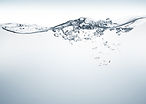Questions and Answers
Most common questions about Ponds.
Why has the water in my pond gone green?
Green water is caused by microscopic algae which float around in the water column. They can turn a crystal-clear pond a bright shade of green in just a few days. They arrive on the wind and flourish when conditions are just right: they use phosphate and nitrogenous compounds, such as nitrate, as a source of food. Sadly, these fertilisers are present in tap water and cannot be easily removed. But they are also produced as a ‘waste product’ by fish and other aquatic organisms.
It is possible to use pond plants to help control phosphate and nitrate, but not all ponds support strong, vigorous and varied plant growth, such as when koi carp are present (they tend to dig up plants), and in some cases it can take two or three years before the plants are well-established.
The easiest and most efficient way to prevent or clear a green pond is with ultraviolet clarification (UVC). UV clarifiers are very effective when installed correctly as part of a filter system or set.
FishLife Pond Services can supply and install a UVC suitable for your pond.
To learn more Check out our video
Do I really need a filter-system for my pond?
Water filtration is a general term that refers to any system or process that is used to filter out particles and pollutants from water.
Nearly all garden ponds benefit from some kind of filter-system, including most (but not all) wildlife ponds.
Broadly speaking a filter-system consists of 3 components: a solids-handling water-pump, an ultraviolet clarifier (UVC) and the filter itself. The system is connected together by flexible hosing or rigid pipe.
In simple terms, the filter-system will achieve three things: 1) clear water, 2) detoxification of waste products produced by the fish and other organisms, therefore keeping the water ‘fresh’ and healthy, 3) the mechanical removal of organic particulate matter (solids/fines). In order to achieve a completely silt-free pond, an exceptionally efficient filter-system would be required, such as a so-called drum filter. But let’s remember that a pond is outside and is naturally subject to falling leaves, blossom, pollen, etc. and all of the myriad processes of nature (death & decay), and it is for this reason that FishLife Pond Services recommend a filter-system, first and foremost, as a way to keep the water CLEAR and HEALTHY for the fish, plants and wildlife. Most filter-systems will help minimise the accumulation of silt and particulate matter, but in our opinion this should not be the main reason for installing a filter-system on your pond. We can advise on which filter-system would be best for your pond. We are an OASE Authorised Installer, but we know our way round most filter-systems
How can I stop blanketweed from growing in my pond?
Blanketweed is present in most garden ponds and is nature’s way of reminding us that we aren’t as clever as she is! Blanketweed is a type of algae which forms long ‘hairs’. It can be wiry or slimy, attached or in clumps, and varies from lime green through to dark green. In short, it grows because there are excess nutrients present. These nutrients may be due to over-stocking with fish or due to the build-up of organic sludge at the bottom of the pond. However, tap-water is also a source of nutriment. The main algae-causing nutrients are nitrogenous (containing nitrogen) such as ammonium. However, phosphate is the main nutrient which stimulates blanketweed to grow.
So in order to prevent/reduce blanketweed, we must reduce the availability of excess nutriment:
-
Keep fish stocking levels low
-
Do not feed too much food and always use a high quality food (the best foods result in less phosphate being metabolised
-
Grow plants (where possible) to out-compete the blanketweed for nutrients
-
Use PhosLess Flow cartridges to ‘filter’ the phosphate from your pond, insert phosphate removal media in the filter, or dose the pond with a phosphate ‘binder’
When should I feed my fish?
In short, when the water temperature is consistently 10C or above.
Fish are ectothermic (cold-blooded) and unlike us, their requirement for food decreases with decreasing temperature. Use a pond thermometer!
Always buy the best food money can buy. There are many different makes and types of food on the market, but most are poor to mediocre in their quality. The best quality foods are normally in pellet form as opposed to stick, and are sold in non-see-through resealable bags as sunlight and oxygen will attack the vitamins in the food.
Look for the wording ‘probiotic’ and ‘multi-season’ as these are generally best.

